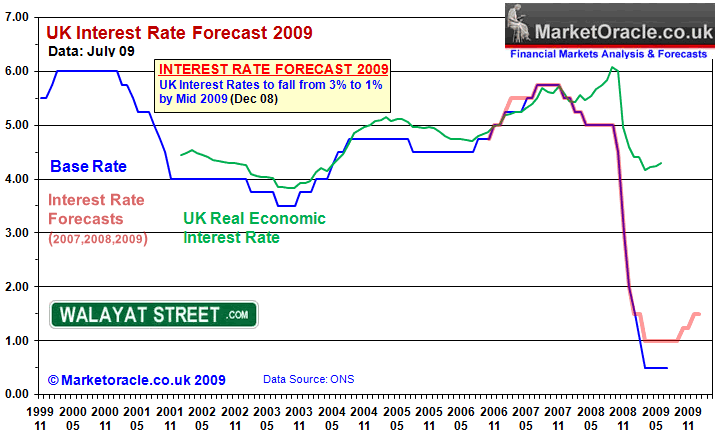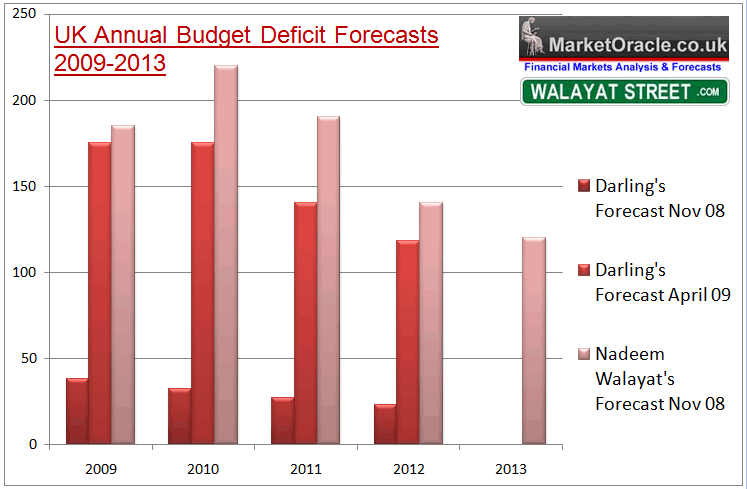Irrelevant UK Base Interest Rate on Hold as Real Rates have Already Begun to Rise
Interest-Rates / UK Interest Rates Jul 09, 2009 - 02:36 AM GMTBy: Nadeem_Walayat
 The Bank of England is expected to keep UK interest rates on hold at 0.5% today for a fourth month. However the deep interest rate cuts have failed to lift the economy out of recession, hence the reason why the Bank of England has detonated the monetary policy equivalent of a nuclear bomb in the form of Quantitative Easing, printing £125 billion of electronic money primarily to monetize government debt to help finance the huge annual budget deficit that is mushrooming towards £180 billion for 2009 alone by artificially keeping longer term interest rates lower.
The Bank of England is expected to keep UK interest rates on hold at 0.5% today for a fourth month. However the deep interest rate cuts have failed to lift the economy out of recession, hence the reason why the Bank of England has detonated the monetary policy equivalent of a nuclear bomb in the form of Quantitative Easing, printing £125 billion of electronic money primarily to monetize government debt to help finance the huge annual budget deficit that is mushrooming towards £180 billion for 2009 alone by artificially keeping longer term interest rates lower.
The existing base interest rate forecast as of December 2008 is for UK interest rates to resume an upward curve towards the end of this year as a consequence of the debt fuelled economic recovery into a projected May 2010 General Election as illustrated by the below graph. UK interest rates hit bottom in March 2009 with the subsequent trend to date inline with the expectation for unchanged rates well into the second half of 2009 with the first rate rise forecast to occur at the October 2009 meeting.

Whilst the base interest rate is at a record low of 0.5%, however the real economic interest rate remains stubbornly high at above 4% and has already started to rise which is reflected in the experience of borrowers that are starting to see significant rise in the interest rate charged by the tax payer bailed out banks, this is set against a LIBOR money market interest rate that continues to fall as the credit crisis eases which has seen LIBOR now fall to 1.18% from 1.65% 3 months ago.
Government Borrowing and Quantitative Easing
The Bank of England has already printed near £125 billion of money so as to buy mainly government bonds in response to the huge budget deficit that the Labour government will rack up by the end of this year that projects to £180 billion against the Labour governments estimate of £38 billion in November. The outlook for subsequent years also remains for bleak with deficits expected to continue for many years as Alistair Darlings own forecast for government net borrowing over the next 4 years has grown from a deficit of £120 billion in November 2008 to £608 billion as of the budget, which is still significantly below my forecast total of £735 billion and therefore the expectation remains for further revisions to the upside over the coming years. This confirms my view that the Bank of England will continue printing money into year end to beyond the current arrangement of £150 billion and probably as high as £250 billion. Which on face value is both inflationary and artificially supportive of the economy, i.e. there will be a day of reckoning for unrestrained money printing and borrowing that projects towards a more severe double dip recession during 2011.

Money printing to artificially reduce market interest rates has succeeded in reducing the short-term money market rates, and in holding down long-term government bond interest rates, therefore boosting the bailed out bankrupt bank balance sheets enabling them to continue paying their executives and senior staff large bonuses whilst little sign of these tax payer owned banks increasing lending to retail customers.
Banks Squeezing Borrowers and Underpaying Savers
As mentioned earlier, the LIBOR interbank rate continues to fall, however the rate charged to borrowers has risen markedly especially hitting mortgage borrowers as illustrated by the below data from the MoneyFacts.

Moneyfacts data is inline with my own research that typically shows an increase in the spread between lending and borrowing from 0.5% in July 2007, having now risen to an eye watering 4.5% above base rate, and 3.75% above the interbank rate. Typically the expectation is for for lenders to charge 1% above the borrowing rates, therefore the average rate should be at approx 2.7% rather than the current rate of above 5% that is being offered to borrowers who meet the tighter lending criteria today. This is as a consequence of the artificial market created as a consequence of government intervention in the form of bank bailouts, nationalisation, capital injections and bad debt insurance totaling more than £1.2 trillion.
Which is enabling banks to effectively funnel tax payers cash onto their balance sheets and hence squeeze the borrowers and savers at the same time due to less supply due to lack of competition. Whereas had the bankrupt banks been allowed to go bust then the market place would have been filled with new entrants rather than bankrupt zombie banks being subsidised by tax payers and hence resulting in lack of market competition, much as occurred in nationalised industries of past.
Interest Rate Outlook Conclusion
The outlook remains for rising market interest rates charged to retail customers, regardless of the direction of the interbank rate and the base rate that is expected to remain at 0.5% into the October 2009 MPC Meeting.
Implications for Savers and Borrowers
Borrowers - Interest rates are already heading higher, the best strategy here would be to try and fix at the best rate available for as long as possible as the consequences off out of control government borrowing will be much higher interest rates.
Savers - Savings interest rates remain significantly below the market lending rates, this is due to the artificial market as a consequence of bank bailouts as in effect it is the savers who are paying for the credit crisis in record low interest rates. However market forces are beginning to reassert themselves in improving savings rates, whilst this is a gradual process it does mean that gradually the huge gap between savings rates and lending rates will begin to narrow, and as lending rates are expected to rise so one can anticipate a greater rise in the savings rates going forward, therefore the strategy would be in favour of not fixing savings rate at this point in time or adopting very short-term fixes if one can obtain a good short-term savings rate i.e. above 4% for 1 year or less.
To receive my in depth analysis on the UK economy, interest rates and housing market subscribe to my always free newsletter.
By Nadeem Walayat
http://www.marketoracle.co.uk
Copyright © 2005-09 Marketoracle.co.uk (Market Oracle Ltd). All rights reserved.
Nadeem Walayat has over 20 years experience of trading derivatives, portfolio management and analysing the financial markets, including one of few who both anticipated and Beat the 1987 Crash. Nadeem's forward looking analysis specialises on the housing market and interest rates. Nadeem is the Editor of The Market Oracle, a FREE Daily Financial Markets Analysis & Forecasting online publication. We present in-depth analysis from over 250 experienced analysts on a range of views of the probable direction of the financial markets. Thus enabling our readers to arrive at an informed opinion on future market direction. http://www.marketoracle.co.uk
Disclaimer: The above is a matter of opinion provided for general information purposes only and is not intended as investment advice. Information and analysis above are derived from sources and utilising methods believed to be reliable, but we cannot accept responsibility for any trading losses you may incur as a result of this analysis. Individuals should consult with their personal financial advisors before engaging in any trading activities.
Nadeem Walayat Archive |
© 2005-2022 http://www.MarketOracle.co.uk - The Market Oracle is a FREE Daily Financial Markets Analysis & Forecasting online publication.
Comments
|
Roy Deskapa
10 Jul 09, 10:21 |
Value of Sterling
Does this mean the value of GBP £ sterling will fall against USD, YEN, EURO, others ? Near term ? Long term? When |



